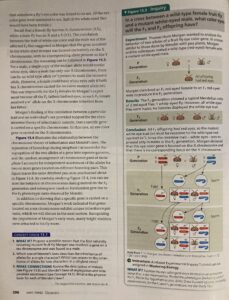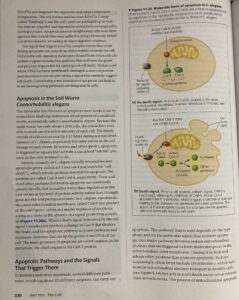I have been reading portions of the textbook, Campbell Biology, 12th Edition, Urry, Cain, Wasserman, Minorsky, Orr, as part of the second semester of a Biology for science majors course I have been taking at the local community college. The textbook has different approaches to presenting different concepts. Three of those approaches are discussed here. (These may not be exhaustive of the methods used to convey ideas in the book -they are just ones that I noticed as I’ve been reading it.)
First Method: Abstract
Some of the material is presented in a very abstract way. For instance, Concept 11.4 “Cellular response: Cell signaling leads to regulation of transcription or cytoplasmic activities” is discussed in the following way:

Note how this section used a lot of complicated jargon. It doesn’t explain how the process it describes could be related to any experiment or physical demonstration to show it working. It just abstractly describes how a cell responds to an extracellular signal that causes a particular gene in the cell’s DNA to start encoding for a particular protein. Your only choice here is basically to memorize the process described, learn the jargon, and then repeat it on a test.
Second Method: Experimental
Some other material in the book is more of a description of the experiments that led to a particular scientific concept. For instance, Figure 15.3, “Inquiry” gives the basic outline of an experiment that was performed to determine that a particular gene for a particular characteristic in fruit flies was located on the X chromosome. (A sex chromosome):

If you follow the explanation presented above, it leads to a very elegant, and easy-to-understand explanation of how they arrived at their conclusion, in my opinion.
Another example of the same approach is seen in a section called “Apoptosis in the Soil Worm Caenohabditis elegans”:

The above discusses an experiment biologists performed on a type of worm to study the phenomena of “apoptosis”, that is, when a cell is programed to self-destruct for the overall benefit of the organism. The above explains that scientists noticed that the “suicide” of cells in this species occurred exactly 131 times during the normal development of this worm. From this, they were able to determine which genes were involved in programing the proteins that cause cell death.
It does not give the specific details of how they determined these were the genes, but it has given a sufficient overall outline, that, for me, the concept was clear: There are certain genes that trigger, after a certain amount of time, and cause the production of proteins that tell particular cells to self-destruct.
Third Method: Historical
The third major method of presenting concepts in the book that I noticed could be described as a “historical” approach. For instance, Chapter 22 “Descent with Modification: A Darwinian View of Life” gives a very historical explanation of Darwin’s theory of evolution through natural selection.
It starts out by describing the history of biology before Darwin. For instance, it discusses Aristotle’s “scala naturae” by saying:
“Aristotle (384-322 BCE), viewed species as fixed (unchanging). Through his observations of nature, Aristotle recognized certain ‘affinities’ among organisms. He concluded that life-forms could be arranged on a ladder, or scale, of increasing complexity, later called the scala naturae (“scale of nature”). Each form of life, perfect and permanent, had its allotted rung on the ladder.”
It then goes on to describe the classification that Carolous Linneas came up with, which used a binomial, two-part system to name species. It then discusses the ideas of Georges Culvier, one of the first paleontologists. He noted that much of the earth was laid out with strata, or layers of rock. He also noted that more dissimilar life forms were located further down, in the older layers of rock. Then geologists started thinking that the Earth was much older than 2,000 years, which suggested there had been enough time for organisms to change from one form to another gradually over time.
The text then discusses a pre-Darwinian concept of evolution based on the idea that organisms that repeatedly use a particular characteristic make it grow stronger, and then that strengthened character gets passed on to their children. (Lamarckian Evolution) This turned out to be largely incorrect, but it was part of the “idea back drop”, or context, from which Darwin was thinking when he came up with his own ideas.
From there, the text discusses Darwin’s voyages on the Beagle, and how that allowed him to confirm the geological ideas of people like James Hutton and Charles Lyell, as well as Georges Culvier. The book then discusses the finches, with different beaks, that Darwin noticed on the Galapagos Islands, and how these birds were similar to a species of finch found on the mainland. This suggested they had come from the mainland, and had changed over time to adapt to the use of different resources. From all of this, Darwin came up with two general observations:
(1) Members of a population often vary in their inherited traits.
(2) All species can produce more offspring than their environment can support, and many of these offspring fail to survive and reproduce.
The book probably could have spent a little bit more time on describing the ideas of Thomas Malthus, which, it is my understanding, is where Darwin got the idea of resources being scarce, and that organisms reproduce past the “carrying capacity” of a particular environment.
The book then went on to say that, based on these observations, Darwin drew two inferences:
(1) Individuals whose inherited characteristics give them a higher probability of surviving and reproducing in a given environment tend to leave more offspring than do other individuals.
(2) This unequal ability of individuals to survive and reproduce will lead to the accumulation of favorable traits in the population over generations.
My point here is not to critique particular sections of the textbook. (Although my particular preferences in terms of how I think scientific material should be presented probably comes through here.) My point is simply to give illustrative examples of what I think are three different ways this particular Biology textbook presents material to the average Biology student. I am not a scientist or a teacher, so I will leave it to others to decide which of these methods of writing a Biology or science textbook is the best. Perhaps all have their place, but the differences in method of presentation should at least be recognized and considered.